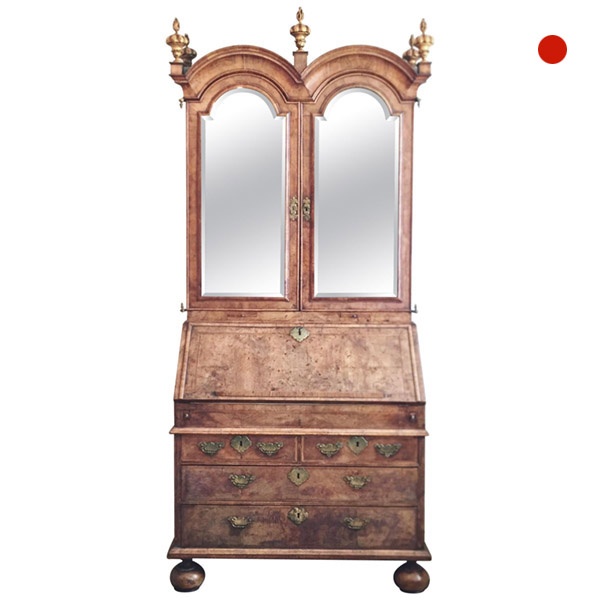Figured Walnut George II 18th Century Kneehole Desk. Circa 1740, England
Sold
Request Information
Follow Us
Figured Walnut George II 18th Century Kneehole Desk. Circa 1740, England
A Fine and Rare Figured Walnut George II 18th Century Kneehole Desk. Circa 1740, England.
The superb age patinated quarter veneered figured walnut top is bordered by a fine holly and ebony stringing, cross-banded, a further stringing of holly and box, cross banded again, and edged with cross-grain ovolo mouldings. Below the brushing slide which is a very unusual and rare feature for a kneehole desk, sits a long oak lined drawer faced with book-matched figured walnut. Similarly, six oak lined drawers bearing their original locks surround the central cupboard which opens on its original shaped and engraved H-hinges to reveal a fitted shelf.
It should be noted that this is an extremely rare example in the most exceptional condition, of superb colour and well patinated throughout.
Condition
Good. Wear consistent with age and use. Sensational colour and patination.
Dimensions
Height: 31.5 in. (80 cm)
Width: 32.29 in. (82 cm)
Depth: 20.87 in. (53 cm)
Literature
‘Early Georgian Furniture 1715-1740’ by Adam Bowett, page 123, plate 3:56.
PREVIOUSLY SOLD

18th-Century George III fitted miniature burr yew and satinwood chest attributed to Ince and Mayhew
A perfectly proportioned miniature chest attributed to Ince and Mayhew. The miniature is of a style that thrived in the latter part of the 18th century, proving popular with nobility and the middle classes. I am not aware of another miniature chest thought to be by eminent makers.

George III Mahogany Serpentine Chest of Drawers
Georgian perfection, 18th century George III mahogany serpentine chest of drawers with brushing slide, fabulous reeded columns and retaining superb original age patinated surface. Choice cuts of flame mahogany veneer sit below the brushing-slide to the four oak lined cock-beaded graduating drawers, which are fitted with their original gilt swan-neck handles, skeleton escutcheons and locks.

Queen Anne Fully Fitted Figured-Walnut Double Dome Bureau Bookcase
Queen Anne Fully Fitted Figured-Walnut Double Dome Bureau Bookcase 1702 to 1714 England SOLD Follow UsQueen Anne Fully Fitted Figured-Walnut Double Dome Bureau Bookcase A Queen Anne Fully Fitted Figured-Walnut Double Dome Bureau Bookcase,...

George III Walnut and Sycamore Comb-back Windsor Chair
The chair is of generous proportions having a large ‘saddle’ style seat carved from a single piece of walnut, surrounded by a gallery back, steam bent horseshoe armrest and solid cabriole legs.

William and Mary Marquetry Chest of Drawers
A William and Mary walnut floral marquetry chest, circa 1690. The rectangular ogee moulded top with central banded oval inlaid with spring flowers, birds and scrolls of acanthus, on ebony ground.

Pair of George III Mahogany Chairs
A fabulous pair of George III mahogany chairs in original ‘country house’ condition. The carved cresting rail is decorated with sweeping softly carved acanthus leaves and centred by a cartouche.

18th-Century George III fitted miniature burr yew and satinwood chest attributed to Ince and Mayhew
A perfectly proportioned miniature chest attributed to Ince and Mayhew. The miniature is of a style that thrived in the latter part of the 18th century, proving popular with nobility and the middle classes. I am not aware of another miniature chest thought to be by eminent makers.

George III Mahogany Serpentine Chest of Drawers
Georgian perfection, 18th century George III mahogany serpentine chest of drawers with brushing slide, fabulous reeded columns and retaining superb original age patinated surface. Choice cuts of flame mahogany veneer sit below the brushing-slide to the four oak lined cock-beaded graduating drawers, which are fitted with their original gilt swan-neck handles, skeleton escutcheons and locks.

Queen Anne Fully Fitted Figured-Walnut Double Dome Bureau Bookcase
Queen Anne Fully Fitted Figured-Walnut Double Dome Bureau Bookcase 1702 to 1714 England SOLD Follow UsQueen Anne Fully Fitted Figured-Walnut Double Dome Bureau Bookcase A Queen Anne Fully Fitted Figured-Walnut Double Dome Bureau Bookcase,...

George III Walnut and Sycamore Comb-back Windsor Chair
The chair is of generous proportions having a large ‘saddle’ style seat carved from a single piece of walnut, surrounded by a gallery back, steam bent horseshoe armrest and solid cabriole legs.

William and Mary Marquetry Chest of Drawers
A William and Mary walnut floral marquetry chest, circa 1690. The rectangular ogee moulded top with central banded oval inlaid with spring flowers, birds and scrolls of acanthus, on ebony ground.

Pair of George III Mahogany Chairs
A fabulous pair of George III mahogany chairs in original ‘country house’ condition. The carved cresting rail is decorated with sweeping softly carved acanthus leaves and centred by a cartouche.
YOU MAY ALSO LIKE
No Results Found
The page you requested could not be found. Try refining your search, or use the navigation above to locate the post.
No Results Found
The page you requested could not be found. Try refining your search, or use the navigation above to locate the post.








